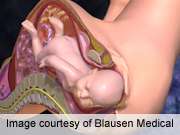(HealthDay)—Non-medically indicated early-term delivery is associated with increased neonatal morbidity and mortality, and interventions to reduce these deliveries are encouraged, according to a review published in the November issue of the Mayo Clinic Proceedings.
Jani R. Jensen, M.D., from the Mayo Clinic in Rochester, Minn., and colleagues discuss the neonatal and maternal consequences of early-term delivery and interventions to reduce these deliveries.
The authors note that neonatal mortality rates are significantly increased at 37 and 38 weeks versus 39 weeks (adjusted odds ratios, 1.9 and 1.4, respectively). Early delivery impacts the neonatal brain, with 1.9- and 1.3-fold higher cerebral palsy rates seen at 37 and 38 weeks, respectively, versus 39 to 41 weeks. Increases in the Mental Developmental Index and Psychomotor Development Scale scores are seen with each additional week of gestation. Maternal complications include longer labor, more interventions during labor, and increased rates of Cesarean delivery, which is associated with underappreciated long-term sequelae. Many women are unaware of early-term delivery-associated risks and the age at which it is safe to deliver a baby; in one study, half of the women believed a full-term pregnancy occurred at 37 to 38 weeks. To decrease the number of non-medically indicated early-term deliveries, hospitals are using different approaches, including "hard-stop" policies, prohibiting this type of delivery; "soft-stop" approach, allowing individual physicians to decide on adherence; and education about associated risks—all of which can reduce early-term deliveries.
"Adoption and enforcement of policies to decrease the rate of elective early-term deliveries may reduce the frequency of these deliveries and, in turn, improve maternal and neonatal outcomes," the authors write.
More information:
Abstract
Full Text
Journal information: Mayo Clinic Proceedings
Copyright © 2013 HealthDay. All rights reserved.



















